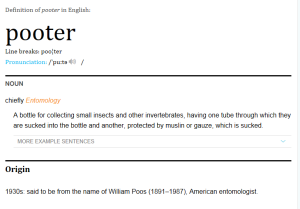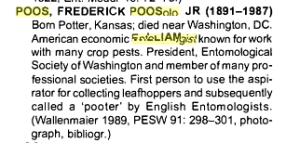I’m sure that we can all remember our first encounter with that wonderful entomological device, The Pooter and were probably all told to remember to “suck don’t blow” and also to remember to suck from the right tube. Despite this sage advice I am also sure that most, if not all of us, have somehow managed to end up with a mouthful of small insects 😉
The Pooter as I came across it first as a student – inherently simple but incredibly breakable http://svalbardinsects.net/index.php?id=33
So exactly what is a Pooter and when was it invented? I of course knew the answer to the first bit but had forgotten the answer to second (if I ever knew it). I decided to see what Google would reveal. A quick Google search led me to this simple definition from http://brainsofsteel.co.uk/post.php?id=Looking-for-Life-in-Your-own-Back-Yard
“The pooter (sic – pedantically as it is named after a person so should be capitalised) is said to get it’s wonderful name from William Poos an American entomologist active in the 1930s, it consists of a small transparent airtight vial with two tubes protruding. One tube is put in your mouth and the other acts as a vacuum that will suck up bugs safely without damaging them. There is an inherent risk of sucking a bug into your mouth but that is half the fun.”
and this one here from http://www.oxforddictionaries.com/definition/english/pooter
and from A Dictionary of Entomology, Gordon Gordh & David Headrick CABI 2011 Second Edition.
So it definitely seemed to appear that the Pooter was a relatively recent invention. Was this true or was it the entomological equivalent of an urban myth? I started with finding out a bit more about the putative inventor of the Pooter, F.W. Poos and found this also in the same source
and after tracking down the obituary by T E Wallenmaier was rewarded with a photograph of the great man.
Next I got hold of Poos’s 1929 paper in which he described the insect aspirator and sure enough there was a diagram of a Pooter pretty much as we know it today but with a cigarette holder as the mouthpiece.
In his paper Poos notes that his design is a modified version of the aspirators used by Kunkel (1926) and Severin & Swezy (1928). So how modified was his design and should the Pooter really be called the Pooter? In the Severin and Swezy paper we are lucky enough to have a photograph of the insect aspirator in action and it is very obviously a straight line system as opposed to the two tubes going in at the top and the text explains that once caught the catch is tapped into another tube or vial.
So what about the earlier Kunkel paper? In this case the photograph clearly shows a sucking tube and another tube in which the
catch is placed by blowing it out of the collecting tube; the Poos version is clearly a more efficient device as you suck and catch and can store your catches until a convenient moment arises for transfer to either your killing jar or observation chamber. As an undergraduate I briefly trialed a Pooter containing cherry laurel (Prunus laurocerasus) to make a combined catching and killing device; needless to say I very quickly decided that it was not a good idea.
So the Pooter is distinct from the other devices in that the catch does not have to be transferred immediately to another container and that it has the sucking and catching ends coming out of the same aperture. Interestingly enough I did find an earlier description of an insect aspirator that had the same properties as the Pooter but was a straight line system (Buxton, 1928). So is the criterion
for a Pooter the two tubes emanating from the same source? Apparently not as I have found these all described as pooters (sic).
Despite all my searching and a resort to Twitter, the earliest reference to an insect aspirator that I could find (many thanks to Richard Jones also known as @Bugmanjones) was 1868 and is basically the same device as that described by Severin and Swezy in 1929.
So if we accept that the Pooter is the classic two tube sucker-storage version then yes, Poos invented the Pooter. If we contend that the Pooter is any old insect aspirator then it seems that Ormerod got there first and we should perhaps only be calling it a pooter because of the noise we make when aspirating an insect 😉
References
Gibb, T.J. & Oseto, C.Y. (2006) Arthropod Collection and Identification: Laboratory and Field Techniques. Academic Press , New York
Kunkel, L.O. (1926) Studies on Aster Yellows. American Journal of Botany, 13, 646-705
Poos, F.W. (1929) Leaf hopper injury to legumes. Journal of Economic Entomology, 22, 146-153
Severin, H.P. & Swezy, O. 91928) Filtration experiments on curly top of sugar beets. Phytopathology, 18, 681-691
Wallenmaier, T.E. (1989) Poos, Frederick, William-1891-1987-Obiturary. Proceedings of the Entomological Society of Washington , 91, 298-301
Post script
I knew I would regret throwing out my old copies of Antenna when I moved to Harper Adams. During my research I came across a reference to some correspondence in Antenna in 1982.
Luckily, Val McAtear, the Librarian at the Royal Entomological Society, very kindly scanned in the relevant pages for me. To my chagrin, I found that I would have saved myself a lot of time if I had remembered this article (Fergusson, N.D.M. (1982) Pooter Post. Antenna, 282-284). On the plus side, I had, however, found several references to insect aspirators that he had not. His additional references are shown below in case anyone wants to track them down.
Baden, E.B. (1951) Collecting beetles associated with stored food products. Amateur Entomologist Leaflet 6, 1-9
Cogan, B.H. & Smith, K.G.V. (1974) Instructions for Collectors. British Museum (Natural History).
Colyer, C.N. & HJammond, C.O. (1951) Flies of the British Isles, Frederick Warne & Co. Ltd.
Hurd, P.D. (1954) ‘Myiases’ resulting from the use of the Aspirator method in the collection of insects. Science, 119, 814-815
Lewis, D.J. (1933) Observations on Aedes aegypti L. (Dipt., Culic.) under controlled atmospheric conditions. Bulletin of Entomological Research, 24, 363-372
Myers, E.H. (1933) A mouth pipette and containers for smaller organisms. Science, 77, 609-610
Oldroyd, H. (1958) Collecting, Preserving and Studying Insects. Hutchinson, London.
O’Rourke, F.J. (1939) Ant collecting. Amateur Entomologist, 4, 33-34
Perkins, J.F. (1943) The collecting trip, in the Hymenopterist’s Handbook. Amateur Entomologist, 7, 140-147
Philip, C.B. (1931) Two new species of Uranotaenia (Culicidae) from Nigeria, with notes ion the genus in the Ethiopian region. Bulletin of Entomological Research, 22, 183-193
Psota, F.J. (1916) A suction-pump collector. Entomological News, 27, 22-23
Wishart, G. (1930) Some devices for handling insects. Journal of Economic Entomology, 23, 234-237
Post post script
Two curiosities that I came across in my foray into the depths of insect aspirator history was a patent filed in 1938 by a Clyde Barnhart for an aspirator designed to reduce wear and tear on the operator
And a mechanical aspirator powered by a car engine (Moore, H,.W. (1943) A mechanical aspirator of sorting and collecting insects in the field. Canadian Entomologist, 75, 162).
And finally
It appears that in the USA poot is analogous to fart!
And now sadly, available in the UK for a mere £12.99 – http://www.thepooter.co.uk/
But the good news is that you can get a real Pooter (albeit plastic) for much less , £1.79 to be precise 😉
http://www.rapidonline.com/science/invicta-insect-pooter-517018

















Sir
Amazing work.
The 1868 reference is not in the list. Besides, the scanned page is not readable.
LikeLike
Thanks a lot for this excellent article. I will use some of the information in our course of ant ecology. Dr Carolina Paris Dep. of Ecology, FCEyN, University of Buenos Aires
LikeLiked by 1 person
Pingback: Will Lucretia Cutter reign supreme? Beetle Queen – the latest sensation from M G Leonard | Don't Forget the Roundabouts
Pingback: Entomological classics – The D-Vac, Vortis and other motorised suction samplers | Don't Forget the Roundabouts
Pingback: Malham again – more fun with the British Ecological Society Summer School #BESUG18 | Don't Forget the Roundabouts
Pingback: Brilliantly, Beautifully Beetle Filled – The Beetle Collector’s Handbook | Don't Forget the Roundabouts
Pingback: The Roundabout Review 2018 | Don't Forget the Roundabouts
Pingback: The Roundabout Review 2019 – navel gazing again | Don't Forget the Roundabouts
Pingback: I Stand in Awe of Matthew Cobb – The Idea of the Brain | Don't Forget the Roundabouts